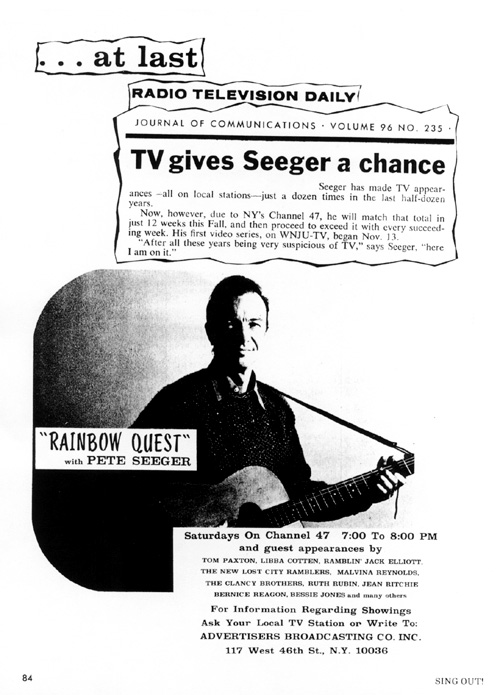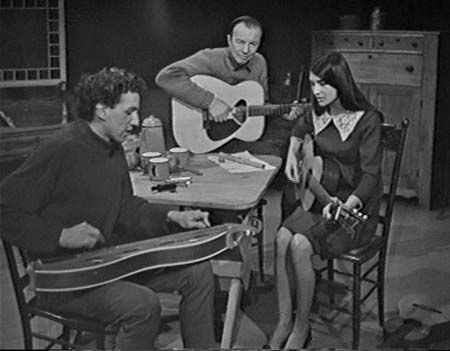
Episode 16: Mimi and Dick Fariņa
Originally broadcast Saturday, February 26, 1966
at 7pm on channel 47, WNJU-TV.
 |
Pete Seeger's Rainbow Quest Episode 16: Mimi and Dick Fariņa Originally broadcast Saturday, February 26, 1966 at 7pm on channel 47, WNJU-TV.
|
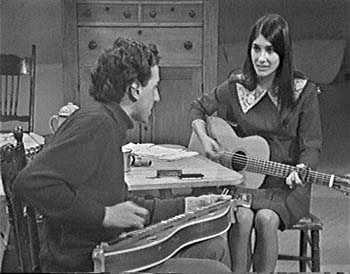 | 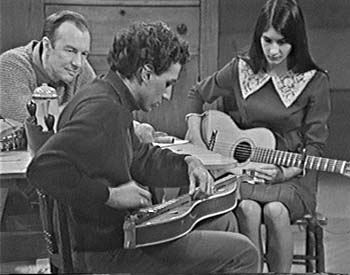 |
|
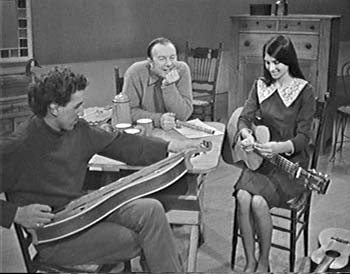 | 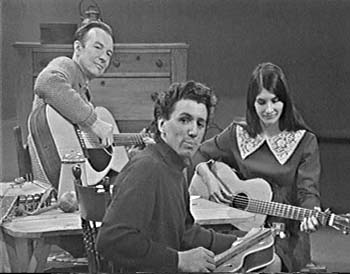 |
|
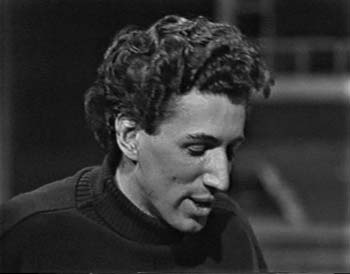 | 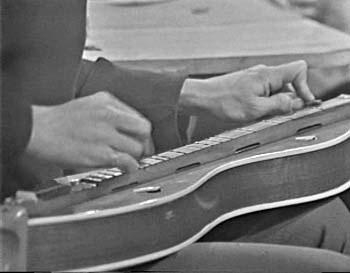 |
|
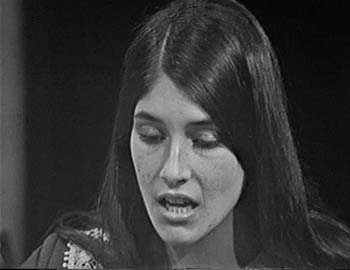 | 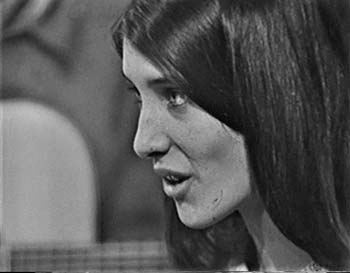 |
Back in the mid-sixties Pete Seeger had an educational TV show called Rainbow Quest. In 1962 the Court of Appeals had ruled that the House Un-American Activities Committee was faulty in its charges against Seeger and dismissed the case against him. With his newfound freedom, Pete was anxious to appear on TV again and promote the cause of folk music. But in spite of the court ruling, networks and sponsors were still wary. The producers of the new show Hootenany claimed that they wanted Seeger, but that the sponsors weren't willing; and the sponsors claimed they wanted Seeger on the show, but that the public wouldn't stand for it.
Following the do-it-yourself ethic of folk music, Seeger finally decided to start his own show, Rainbow Quest. It began on UHF channel 47 in New York and had only been picked up by seven stations when Seeger began to run out of funds. During its brief run of 38 episodes, Pete talked and strummed with such guests as Elizabeth Cotten, Patrick Sky, Donovan, Judy Collins, and Buffy Sainte Marie. Richard and Mimi Fariņa also appeared on the show in February of 1966.
This episode is a must-see for all Fariņa fans.
Richard and Mimi perform several of their own songs and back up Seeger
on some other songs. They also
talk about their involvement with Joan's Institute for
the Study of Non-Violent Action. Oddly enough,
there was little talk of Richard's forthcoming novel and no mention of his
work on Joan's
rock album (perhaps because it was an educational show avoiding
commercialism or promotion).
Seeger shows his considerable knowledge of folk music through many
observations of Richard and
Mimi's music. He notes how Richard combines two or three old
traditions on the dulcimer and improvises and accelerates like a sitar
player as he and Mimi trade off rhythms. Seeger also recalls their
Newport Folk Festival performance, when the couple performed in the rain and
inspired the audience to get up and dance and take off their clothes. Seeger
describes this as a sight that "I'll never forget in all my life...It was
pandemonium...it was wonderful!"
Richard is suprisingly nervous in this video;
readers who were enchanted by Hajdu's evocative portrait of Fariņa as the
mercurial entertainer who turned every conversation into theatre, every meal
into a banquet, may be surprised to find him so demure here, although
both of them loosen up somewhat after
a few songs, especially on the upbeat numbers, "House Un-American Blues
Activity Dream" and "Joy 'Round My Brain."
Production values have changed enormously in 35 years, and the modern viewer
raised on flashy MTV videos may feel something missing in this footage. There is no rapid
splicing, no computer graphics flying across the screen; the set is a
dark, bare kitchen in what looks like a log cabin; there is no studio
audience, and when you expect applause at the end of Richard and Mimi's
fantastic performances, there is only a brief, awkward silence, followed by
Pete saying "WOO-WEE!" But the historical
value of this video lies partly in the slight culture shock
one experiences. It's like traveling back in time.
Pete clearly admired Richard and Mimi's music, and even predicted that their
synthesis of various eclectic styles would be influential: "This is going
to be happening all around the world." And indeed, a year or two later,
popular music explored a bewildering array of styles (though Richard and Mimi
received scarcely any credit for helping to initiate this trend). Pete ended
the show by saying,
"You ain't seen nothin' yet." Sadly, we would see no more of Richard and Mimi
as a duo. This was one of the last--if not the
very last--recording of Richard and Mimi, as Richard died a month later.
This is a unique opportunity to observe Richard's dulcimer
technique and to see Mimi's guitar playing. I found it fascinating just to watch
them moving and talking.
It's also impressive to hear Seeger improvise
so effortlessly on the duo's songs. Although Richard and Mimi only appear
on the show for maybe 35 or 40 minutes, it is nevertheless a priceless piece
of history and absolutely a must-see for any fan of theirs. Unfortunately, it is currently
out of print, but you can see some clips on Youtube.
Oh, Had I A Golden Thread (Rainbow Quest theme song)
I'm familiar with the Farinas, having played most of their music on dulcimer
and guitar. Even so, it was exciting to see a video of their performance, to
actually see them, and to watch their playing styles.
Richard ran his left-hand dulcimer bass sequences using his thumb as a noter,
with his fingers serving as a sliding guide along the outer edge of the
fretboard. In treble, he palmed a noter, gripping it with thumb and forefinger,
the other fingers curled in. For multi-string treble note sequences, hammer-ons/
pull-offs, single-note and barre-harmonics, he'd anchor his hand with thumb on
the soundboard and play it like a piano.
With his right hand, it looked like he used a Fender full triangle light-guage
pick, chasing his fretting fingers and thumb up the scalloped fretboard as far
toward the nut as the existing playing range comfortably allowed, unless it was
necessary to shade the tone by dropping back to the recession near the bridge.
Mimi and Richard played a dazzling mix of rhythms with dulcimer and guitar,
accenting them with open and muted strums, blending them with the same intrigue
and enchantment as their vocal harmonies. Into this mix throw a blues harp,
maracas, a duck-call and Pete Seeger's 12-string guitar and 5-string banjo. Yes!
(Did I mention that I was a fan?)
A review wouldn't be complete without commenting on Richard's lyrics. He has
written many beautiful and poetic pieces, but among his work are quite controversial
songs criticizing and lampooning irresponsible government and the senseless
pursuit of war (this was during the Viet Nam conflict). Like Pete, Phil Ochs,
et al, they didn't get much in the way of air play on radio or television.
Pete had to be affected by Richard and Mimi's performance of "House Un-American
Blues Activity Dream", having so recently been freed from the years of haranguing
pursuit by HUAC and the resultant ostracizing, threats and violence to which he
and his family had been subjected (HUAC got plenty of air play). A similar
song "Bold Marauder" depicts a nation of hubris, making because it can,
insatiably seeking greater power and wealth....
At one point all 37 episodes were available on video from Norman Ross Publishing.
Unfortunately, all the videos are out of print. Shanachie has released a few
episodes on DVD. Sadly the Fariņa episode is not among them, but they are
moderately priced and with two episodes per disc, and they are all of great
historical importance and worth watching.
Available:
Richard & Mimi on Rainbow Quest:
Songs (with Richard and Mimi songs in red):
I Know Where I'm Going (Handsome Johnny)
Lonesome Valley
Dopico / Celebration for a Grey Day
Pack Up Your Sorrows
Bold Marauder
House Un-American Blues Activity Dream
All Mixed Up
Traveling Man
Joy 'Round My Brain
Careless Love
Oh, Had I A Golden Thread
A Review:
Excerpt from Local Lore, newsletter of the Portland Folklore
Society, vol. 27, no. 2, March-April 2003. By Erik Wikner.
Rainbow Quest episodes on video and DVD:
605 - Stanely Brothers & the Clinch Mountain Boys with Cousin Emmy; Doc Watson with Clint Howard & Fred Price
606 - Johnny Cash & June Carter; Roscoe Holcomb with Jean Redpath
607 - Sonny Terry & Brownie McGhee; Mississippi John Hurt, Hedy West & Paul Cadwell
608 - New Lost City Ramblers; The Greenbriar Boys
609 - Clancy Brothers & Tommy Makem; Mamou Cajun Band
610 - Judy Collins; Rosa Valentin & Rafael Martinez and Elizabeth Cotten
Finally, an ad for the show from Sing Out! magazine,
vol. 16, no. 1, February/March 1966, page 84.
